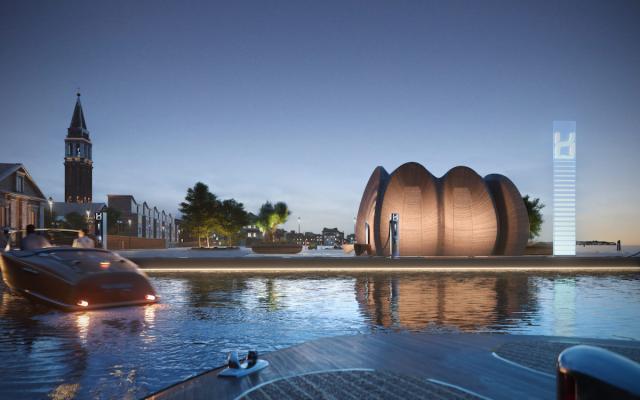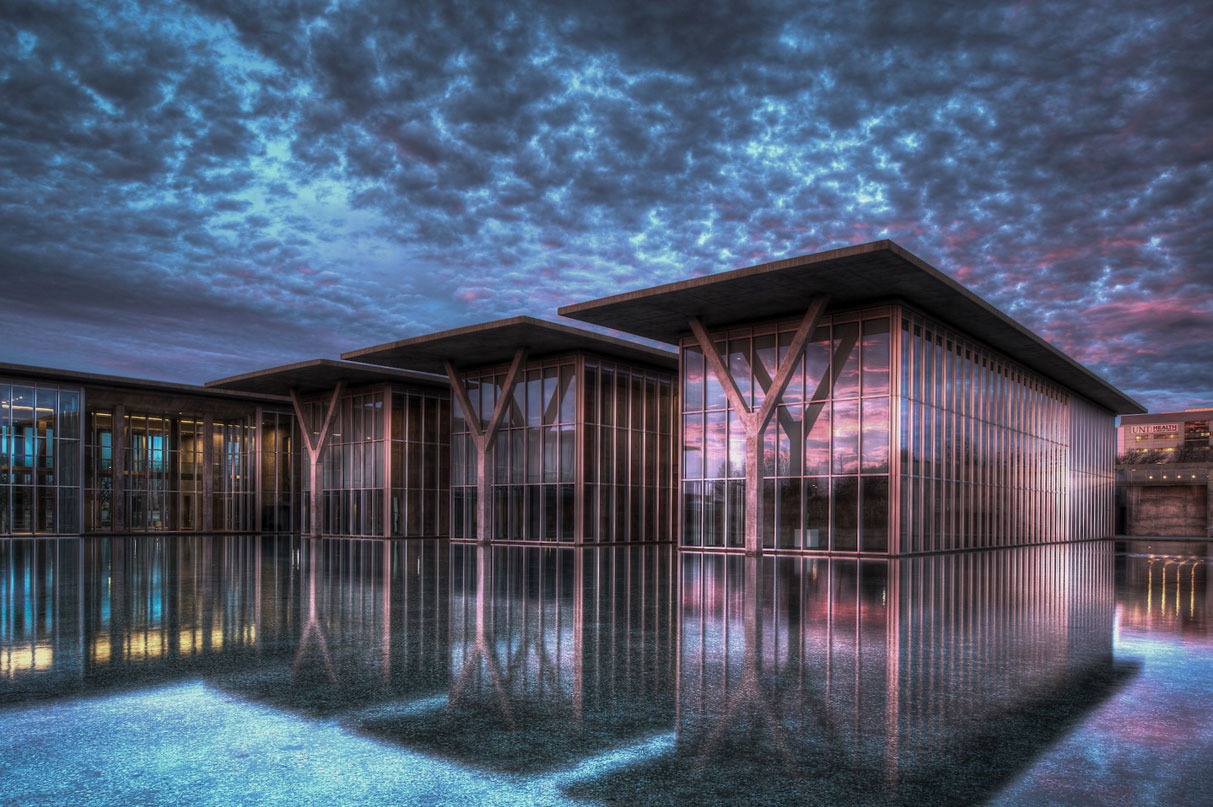Qui vivra verra, Qui mourra saura
2019 - Installation (Installation)
Dimensions variable
Minia Biabiany
Qui vivra verra, Qui mourra saura is an installation by Minia Biabiany composed of the plan of a house made out of strips of salt, and a “garden” made of ceramic pieces, hanging from the ceiling and on the floor, and non woven fabric. She uses blue and red filters to alter the hues of light coming from the outside. The work focuses on the disappearance of traditional knowledge associated with the “jardin de case” outside Guadeloupean houses. This type of garden is closely linked to the enslaved people of Guadeloupe, a manifestation of a coexistence between people and other species, and between the living and the dead. The garden surrounding the case is made out of successive “shells” of ornamental, medicinal or therapeutic plants that protect and heal its inhabitants, or embellish this private place sitting in plain view. The extendable basic unit of the case itself is a two-room structure, each room measuring approximately 9 × 18 feet, covered by a gable or hipped roof made of metal sheets. The larger sides have two doors, and the shorter sides one door. The house may be extended by connecting extra rooms to the French windows, which then become part of the inside of the building. The case thus forms a labyrinthine space evolving along with the needs of the family. Its structure denotes a concern for protection, visible through the carefully tidied surroundings and the presence of protective plants preventing acts of witchcraft from spirits or objects placed around the house. The colors of the exterior walls also refer to the diplomatic relations between the inhabitants and the spirits (benevolent or evil). Blue signifies maximal protection while red repels attacks and vibrates with power. Finally, according to its dominant color and the shape of its leaves, the same plant will have a different name depending on its location. Planted in front of the house, “Qui vivra verra” (“They who live shall see”) contributes to the inhabitants’ longevity; in the backyard, “Qui mourra saura” (“They who die shall know”) supports the passing of knowledge between generations. The organization of the jardin de case is a preeminent site for negotiation and mediation with the invisible world. While its shell structure remains visible today, its meaning has almost completely vanished.
Minia Biabiany’s practice is concerned with the past and ongoing effects of colonialism, exploring the poetics of resistance embedded in everyday life practices, and translating this research into the exhibition space through careful consideration of the cultural and spiritual implications of the material she uses, and the techniques she employs. She is interested in the specificities of the Caribbean and the complex cultural interactions that circulate in and around it. More recently, her work also approaches healing and sexuality and their potential for liberation in a feminist sense. In 2016, she initiated the pedagogical and artistic project Semillero Caribe [Caribbean Seedbed]: an experimental seminar based on exercises with the body and drawing engaging with concepts of Caribbean thinkers.
Colors:
Other related works, blended automatically
» see more

© » KADIST
Minia Biabiany
2020Musa is a visual and textual work by Minia Biabiany and the starting point of a broader research around the sexuality of Caribbean women, the historical legacy of slavery, and the artist’s own female lineage...
Related works sharing similar palette
» see more

© » ARTS EQUATOR
Migrant Ecologies Project: A Grain of Wheat Inside a Salt Water Crocodile | ArtsEquator Thinking and Talking about Arts and Culture in Southeast Asia Grain of Wheat July 8, 2019 For the benefit of the possible intelligences that may find these treasures after humans have long gone, we have translated one of the photographs of our wheat gleaning ceremony in Singapore into binary code...

© » ART & OBJECT
Zaha Hadid Architects Unveil Hydrogen Refueling Station, and More News | Art & Object Skip to main content Subscribe to our free e-letter! Webform Your Email Address Role Art Collector/Enthusiast Artist Art World Professional Academic Country USA Afghanistan Albania Algeria American Samoa Andorra Angola Anguilla Antarctica Antigua & Barbuda Argentina Armenia Aruba Ascension Island Australia Austria Azerbaijan Bahamas Bahrain Bangladesh Barbados Belarus Belgium Belize Benin Bermuda Bhutan Bolivia Bosnia & Herzegovina Botswana Bouvet Island Brazil British Indian Ocean Territory British Virgin Islands Brunei Bulgaria Burkina Faso Burundi Cambodia Cameroon Canada Canary Islands Cape Verde Caribbean Netherlands Cayman Islands Central African Republic Ceuta & Melilla Chad Chile China Christmas Island Clipperton Island Cocos (Keeling) Islands Colombia Comoros Congo - Brazzaville Congo - Kinshasa Cook Islands Costa Rica Croatia Cuba Curaçao Cyprus Czechia Côte d’Ivoire Denmark Diego Garcia Djibouti Dominica Dominican Republic Ecuador Egypt El Salvador Equatorial Guinea Eritrea Estonia Eswatini Ethiopia Falkland Islands Faroe Islands Fiji Finland France French Guiana French Polynesia French Southern Territories Gabon Gambia Georgia Germany Ghana Gibraltar Greece Greenland Grenada Guadeloupe Guam Guatemala Guernsey Guinea Guinea-Bissau Guyana Haiti Heard & McDonald Islands Honduras Hong Kong SAR China Hungary Iceland India Indonesia Iran Iraq Ireland Isle of Man Israel Italy Jamaica Japan Jersey Jordan Kazakhstan Kenya Kiribati Kosovo Kuwait Kyrgyzstan Laos Latvia Lebanon Lesotho Liberia Libya Liechtenstein Lithuania Luxembourg Macao SAR China Madagascar Malawi Malaysia Maldives Mali Malta Marshall Islands Martinique Mauritania Mauritius Mayotte Mexico Micronesia Moldova Monaco Mongolia Montenegro Montserrat Morocco Mozambique Myanmar (Burma) Namibia Nauru Nepal Netherlands Netherlands Antilles New Caledonia New Zealand Nicaragua Niger Nigeria Niue Norfolk Island Northern Mariana Islands North Korea North Macedonia Norway Oman Outlying Oceania Pakistan Palau Palestinian Territories Panama Papua New Guinea Paraguay Peru Philippines Pitcairn Islands Poland Portugal Puerto Rico Qatar Romania Russia Rwanda Réunion Samoa San Marino Saudi Arabia Senegal Serbia Seychelles Sierra Leone Singapore Sint Maarten Slovakia Slovenia Solomon Islands Somalia South Africa South Georgia & South Sandwich Islands South Korea South Sudan Spain Sri Lanka St...

© » SLASH PARIS
Anne Deguelle — L’Arctique fantôme — L'ahah Moret — Exposition — Slash Paris Connexion Newsletter Twitter Facebook Anne Deguelle — L’Arctique fantôme — L'ahah Moret — Exposition — Slash Paris Français English Accueil Événements Artistes Lieux Magazine Vidéos Retour Anne Deguelle — L’Arctique fantôme Exposition Photographie À venir Anne Deguelle, Glacier, 2014, 40 × 53 cm © Adagp, Paris, 2023 Anne Deguelle L’Arctique fantôme Dans environ 2 mois : 27 janvier → 17 février 2024 vernissage le 27.01.24, 17h → 21h exposition du 27.01 → 17.02.2024 L’ahah #Moret 24-26, rue Moret, 75011 Paris L’ahah est heureuse de présenter cet hiver en L’ahah #Moret une série singulière de photographies dans l’œuvre de l’artiste Anne Deguelle ...
Other works by: » Minia Biabiany
» see more

© » KADIST
Minia Biabiany
2020Musa is a visual and textual work by Minia Biabiany and the starting point of a broader research around the sexuality of Caribbean women, the historical legacy of slavery, and the artist’s own female lineage...
Related works found in the same semantic group
» see more

© » KADIST
Rometti Costales
2013This anarchist flag is made from Huayruro seeds, a native plant of South and Central American tropical areas...

© » SLASH PARIS
Santídio Pereira — Un horizon végétal — Galerie Xippas — Exposition — Slash Paris Connexion Newsletter Twitter Facebook Santídio Pereira — Un horizon végétal — Galerie Xippas — Exposition — Slash Paris Français English Accueil Événements Artistes Lieux Magazine Vidéos Retour Santídio Pereira — Un horizon végétal Exposition Dessin, estampe, lithographie / gravure, peinture.....

© » KADIST
Vvzela Kook
2019Columbus of Horticulture stems from Vvzela Kook’s ongoing research into the central and often-ignored role that botany played in the history of European imperialism...


